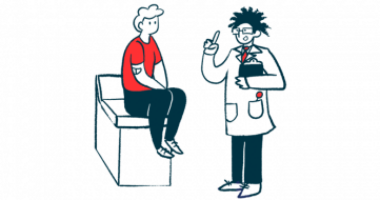Dry needling part of PT routine for sciatic nerve pain
Patient with SMA finds treatment helpful with hip pain

Emily Jones and Ken Wheeler prep Michael Morale for sciatic nerve dry needling. (Photo courtesy of Michael Morale)
Michael, a patient I work with who has spinal muscular atrophy (SMA), sits for extended amounts of time in his wheelchair as he is unable to stand. He transfers between his wheelchair and bed during the day and stays in his bed during the afternoon and night.
Over the years, he has developed severe right hip pain with referral pain down into his right calf from the pressure on the nerve from constant sitting and not being able to shift weight frequently independently. Throughout the past two years as the pain has increased, we have attempted many activities, including wheelchair changes with posturing and a new cushion.
While these have helped temporarily reduce the pain, nothing has significantly made any lasting changes. We decided to give dry needling a try again with a more focused intent this time. We discussed trying dry needling closer to where he is experiencing the compression in his hip in attempt to get a significant amount of distraction in the tissues.
To perform this, we transferred Michael onto the treatment table and got him as comfortable as possible in a side lying position on his left side so that his right hip was exposed.
While in a comfortable position and with his right hip exposed, we palpated to find where the pain begins and locate most of the compression. After finding that spot, we positioned needles in that area to reach a bony backdrop in different locations. Those needles were then moved in a twisting motion to increase the resistance in the tissues and then pulled gently away from the tissues to create a deep stretch.
After that, electrodes were attached to the needles to create a muscle twitch and relax the musculature around the area. This helps continue to reduce compression in this area and get relief where we can.
Michael has also had some changes in his pain medication over the past week, so we will continue to monitor for any reduction in pain and improvement in function. This will be repeated over the next few months with possibly some cupping performed as well. Cupping will be performed with silicone cups placed on this area to continue to pull pressure off the tissues and attempt to give the nerves some relief to reduce the pain going down his leg.
The dry needling and cupping combination will allow for increased amounts of tissue stretching in this area.
We will continue to attempt any other treatments and modalities that may help to reduce Michael’s pain and improve his function, as well as monitor his pain and continue to progress as he tolerates.
Patient perspective
While most people would get nervous if they saw somebody coming at them with a box of needles, I cherish the sight of those tiny things. If you ask any patient with SMA, they’ll probably tell you that they’re not scared of needles because they’ve had so many of them in their lifetime. Dry needling is becoming a routine therapy my physical therapist and I are using, and I’ve actually been quite surprised at the results.
A few years back, I was having trouble with a muscle in my right forearm. This muscle kept twitching, making it almost impossible for me to drive my electric wheelchair and use my computer’s mouse. Dry needling was used to calm this muscle down, and massage therapy was also used to help quiet this muscle down. This was my first venture into the world of dry needling, and I was extremely happy with the results.
Emily is excellent at dry needling, and this, along with cupping, will probably be a permanent part of my physical therapy routine moving forward. If you’re a physical therapist reading this article, please talk to your patients about the benefits of dry needling and cupping.



